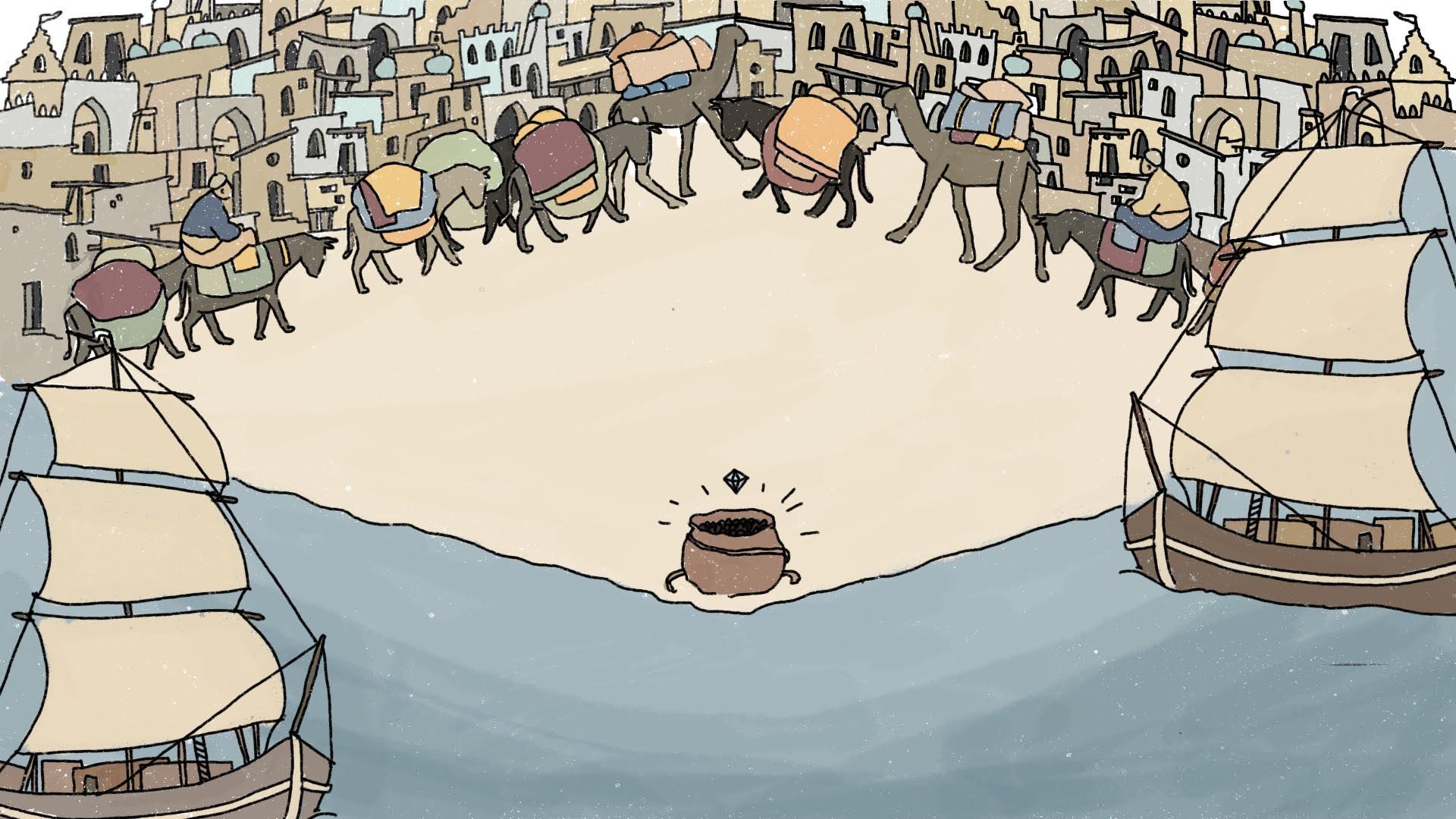
Routes of Riches
how spice trade shaped the world
by Ipsita Choudhury
Mentored by Prasanta Kumar Dutta, Sudev Kiyada, Chakradhar Saswade
In the quiet corners of history, among the trade winds and sails of ancient ships, lies a story as aromatic as the spices that have travelled across continents. Welcome to the story of the Spice Trade: a journey that transcends borders, cultures, and centuries, leaving an indelible mark on the world we know today.

Though spices may seem ordinary today, their historical significance as coveted treasures not only fueled trade routes but also facilitated cultural exchanges and geopolitical shifts, playing a pivotal role in shaping our interconnected world.
Cinnamon
Cumin
Turmeric
Cardamom
Clove
Nutmeg



Spices are natural substances derived from various parts of plants, such as seeds, bark, roots, fruits, or leaves, and are used to flavor, color, or preserve food. They play a crucial role in enhancing taste and aroma of food. They also have multiple medicinal and preservative properties.
In antiquity, spices went beyond culinary use; they symbolized status, were traded as treasures, held medicinal value, and played a role in religious practices. Their pursuit fueled exploration, shaped trade routes, and united diverse cultures, weaving spices into the rich history of human civilization.
Spices weren't just kitchen treasures; their value surpassed gold (by a lot)!
Spices had preservative, medicinal, spiritual and flavourful attributes. They also were a class symbol!


Ever wondered why Indians put haldi and dhania in their pasta?
That might be because they have been fascinated with spices ever since they discovered them in their backyard.
Spices originated in diverse landscapes, from the lush valleys of India and the tropical spice gardens of Southeast Asia to the sun-drenched hillsides of the Mediterranean.
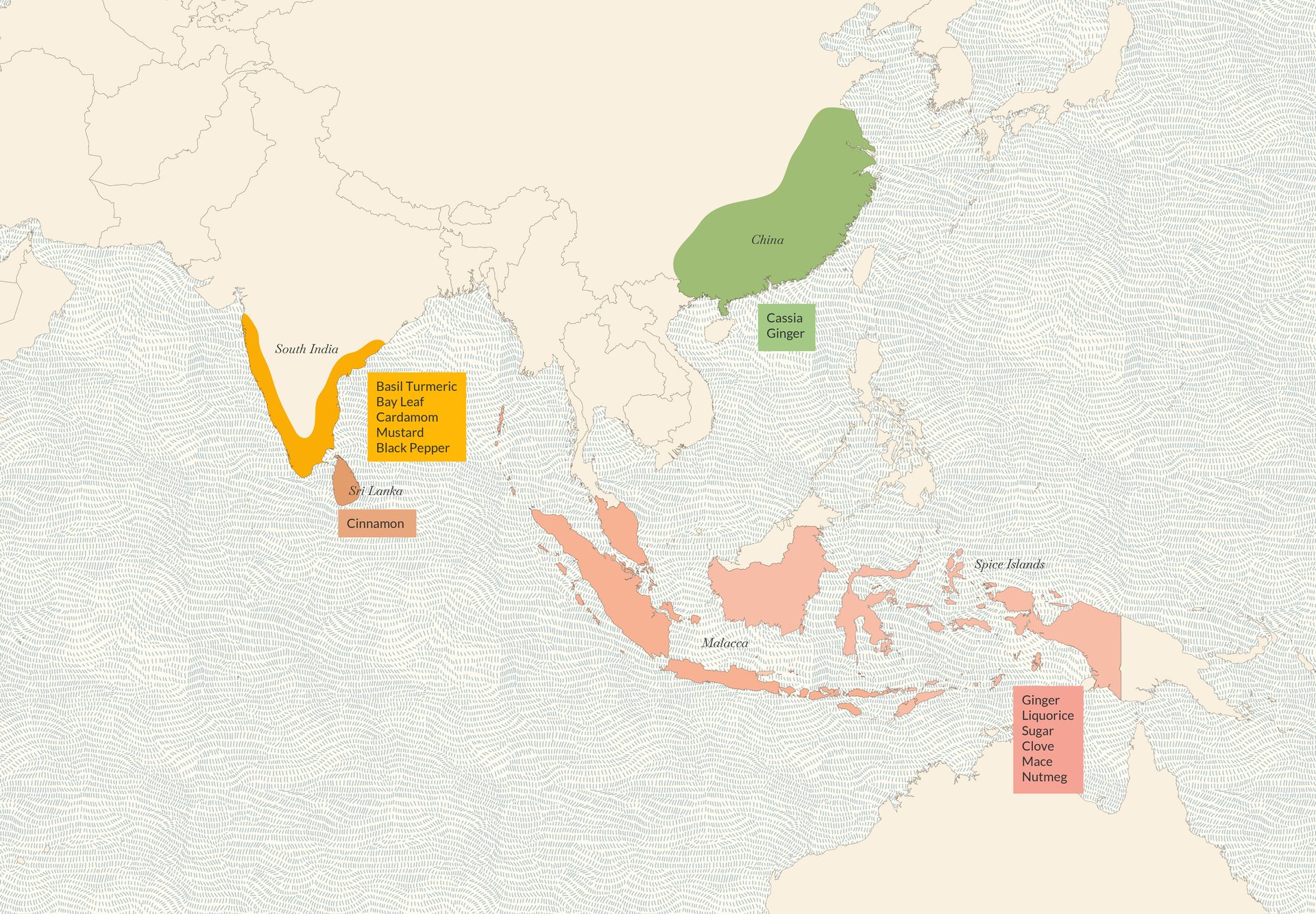
The Origin of Spices
Back in the spice-hunting heyday, folks weren't going to the local kirana – they were crossing deserts and seas just to get some elaichi!
You might see multiple spice jars in your cabinet today, but


Spices were such a hot commodity for trading, not just because of their value, but also because they were very easy to trade. Spices are small in weight and volume, and they don't go bad for long. This made the spice business an extremely lucrative one. Camels or ships could carry spices worth a gigantic value without much trouble.
The Spice Journey




Pre-historic trade (2000 BCE)
The Indian subcontinent engaged in trade with Egyptian and Mesopotamian civilizations via the Indus Valley and Incense Route.
Alexandria opens trade links between Europe and Asia (331 BCE)
Alexander the Great built the city of Alexandria in 331 BC, which created a sea link between Africa/ Middle East and Europe, facilitating the flow of spices from India to Greece.
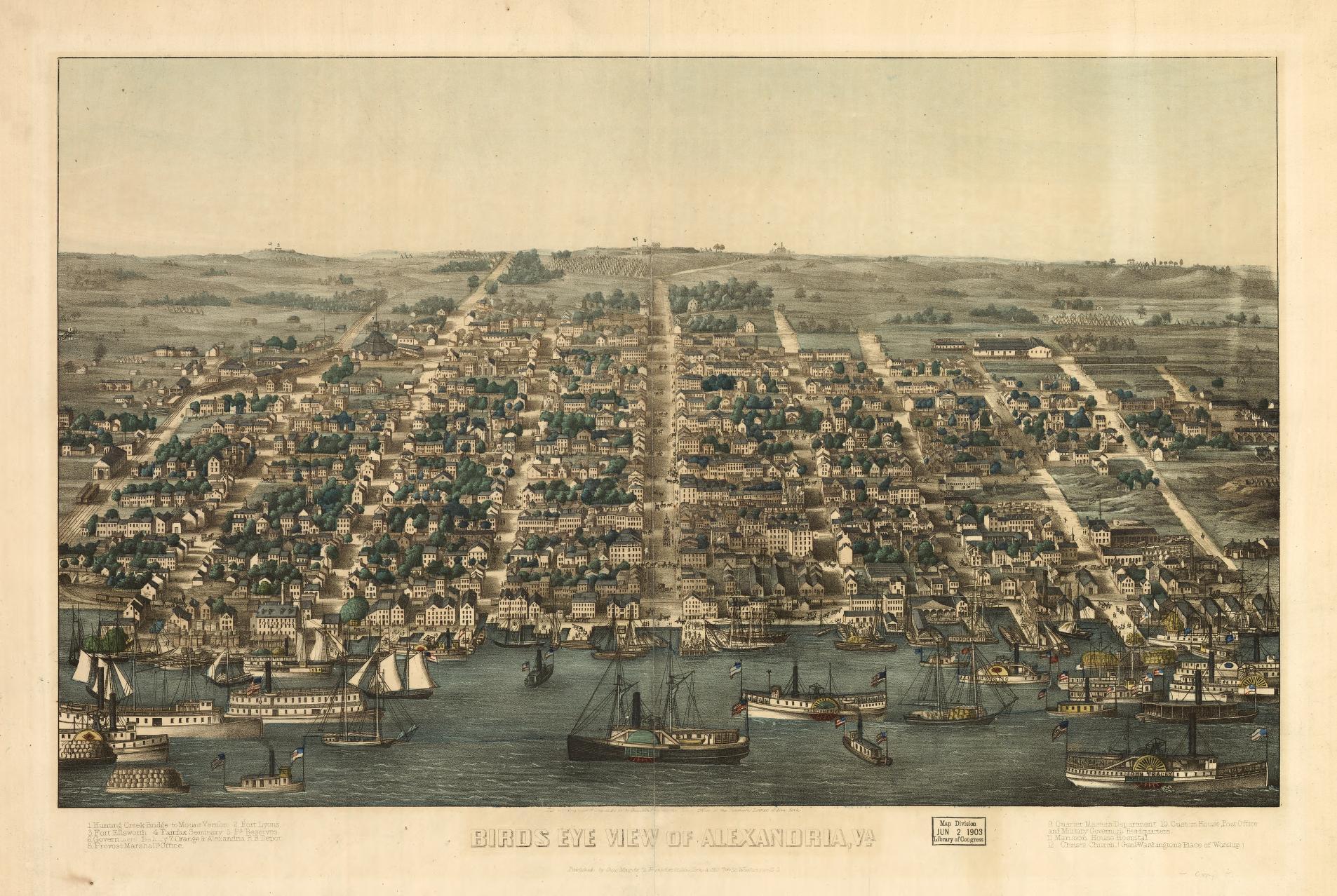
Birds Eye View of Alexandria by Charles Magnus (1863)
Trade was not limited to the west of the Indian peninsula, it also was opening up on new routes towards the East.
Moving Eastwards
While trade networks were developing in the west of the Indian subcontinent...
Maritime Links: India, Indonesia, and China (200 BCE)
...some trade routes were established, connecting India, Indonesia, and China. These routes, however, were weak due to the lack of technological advancements in maritime trade.
The Silk Road
The Silk Road was a network of trade routes, connecting various cities and towns through China, Central Asia and later reaching westwards to Europe, connecting the Indian subcontinent in the way. This historical marvel fostered the flow of goods, ideas, and cultural treasures across vast landscapes
Double-click to select video
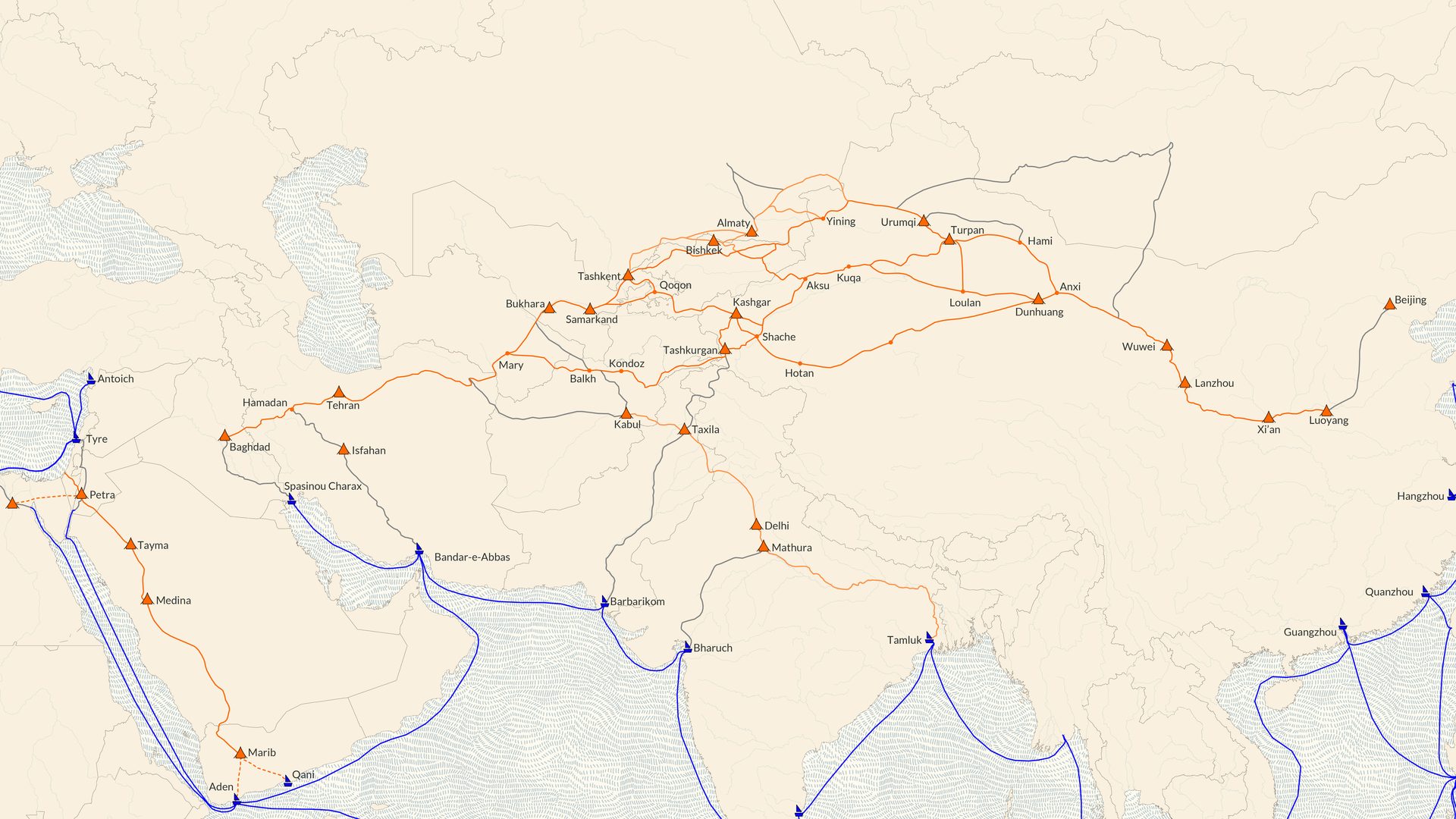
Some fascinating Horses (amongst other things) initiate the Silk Route trade (130 CE)
Emperor Wu Di of the Han Dynasty sent explorer Zhang Qian westward in the 2nd century BCE to establish alliances against the Xiongnu. During his 138-126 BCE journey, Zhang Qian reached the Fergana Valley, uncovering new allies and a treasure trove of goods unknown to the Chinese.
Zhang Qian's reports of exotic goods like silk, precious gems, horses, and spices fascinated the Chinese court. Recognizing economic potential, Emperor Wu Di envisioned a direct trade route to these regions. The Silk Road, named after its lucrative silk trade, began to take shape.
What did Horses have to do with the Silk Route?

Lady Guoguo's Spring Outing by Zhang Xuan (618 CE)
Mixed Media Trade: The Romans discover methods to navigate the Nile, and dismantle their ships to traverse West African deserts, ultimately reaching the Arabian Seas. (50 BCE)
After taking control of Egypt, the Roman Empire found an alternate way to reach India via the Nile and the kingdom of Aksum. Their ships were built to be dismantled and reassembled, to fit the river-land-sea route they took.
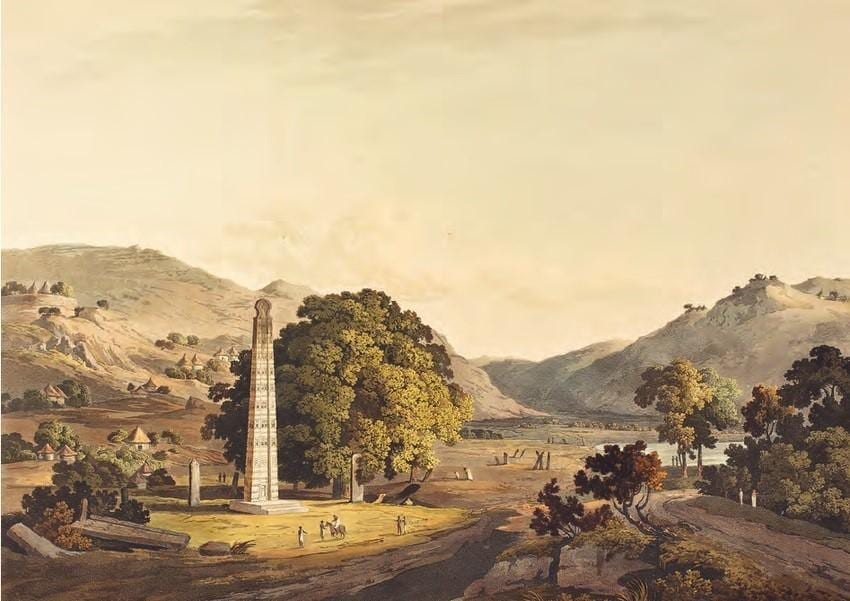
Obelisk at Axum by Daniel Havell (1809)
Connecting the Dots: The Romans complete the Silk Route to connect Asia, Africa and Europe (150 CE)
Romans extend the Silk Route westward to Europe via the port of Antoich, connecting the overland Silk Routes to the maritime routes between Africa and Europe
Constantinople: The crossroad between Europe and Asia (330 CE)
When the Roman Empire shifted its capital to Constantinople from Roman, it turned into a trade hotspot. This was helped by the fact that it physically an culturally was considered to be where the East and West met.
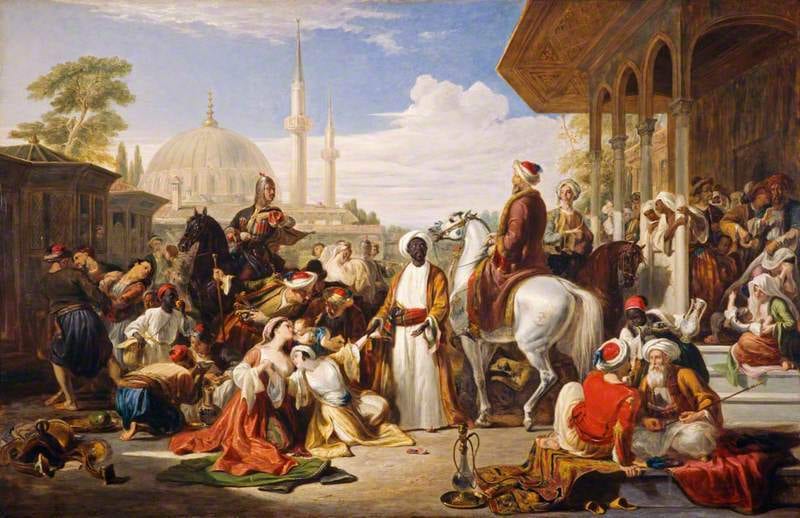
Slave Market at Constantinople by Sir William Allan (1782-1850)
During the Tang Dynasty (618–907 CE) and the subsequent Song Dynasty (960–1279 CE), China grappled with a few challenges. Their conflict with some Turkik and Central Asian groups in the West meant that there was a constant risk of attacks on the Silk. Route. The overland route also took a long time; meaning that trade was slow.
Prompting the shift of China's economic focus from overland to maritime trade, the Chinese government began investing in a strong navy, emphasizing sea routes for trade to bypass the land routes plagued by conflicts.
One significant development was the establishment of the Maritime Silk Road during the Song Dynasty. The Southern Song emperors actively promoted maritime trade, and major ports such as Quanzhou and Guangzhou became thriving centers for international commerce.
Seas of Diplomacy: China's Maritime Shift
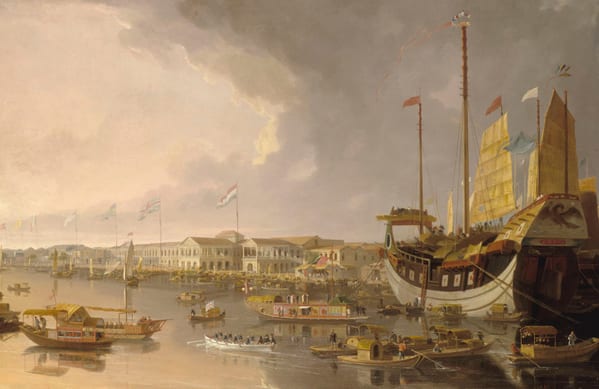
The Port of Canton (United States) trading with foreign merchants in the middle of the Qing Dynasty
(National Maritime Museum)
Chinese Maritime Silk Route (800 CE)
The Chinese ports at Quangzhou and Guangzhou, thrived as economic centers, anchoring the maritime Silk Route. This started the period of a very strong sea link between the East and West.
The Crusades, initiated by the Pope, started a wave of occupation of multiple cities. This influenced trade dynamics in Europe, taking over ports in the Levant, which consisted of the important ports of Antoich and Tyre. This led to the Italian city-states of Venice, Genoa and Pisa controlling trade in the Mediterranean region for all of Europe. The riches brought to these cities due to the spice trade led to art and architecture movements like the Renaissance.
The Mediterranean Monopoly
Crusades' Impact (1000 CE)
The Levantine Ports come under the Venetian control, which redirects all trade in the Mediterranean to the Italian city-states of Venice, Pisa and Genoa.

In a Levantine Port by John Singer Sargent (1905-06)
The Middle Eastern Monopoly (1400 CE)
Since all the spice trade went through the Middle East, the Arabs enjoyed a monopoly over the same. The European Christian countries were not just envious of the riches it brought them, but they also were unwilling to deal in trade with the Islamic states.
The Fall of Constantinople (1400 CE)
Constantinople fell to the Ottoman Empire, which stopped all trade activities in the city. The Italian cities of Venice, Genoa and Pisa took further advantage of this disruption and prospered.
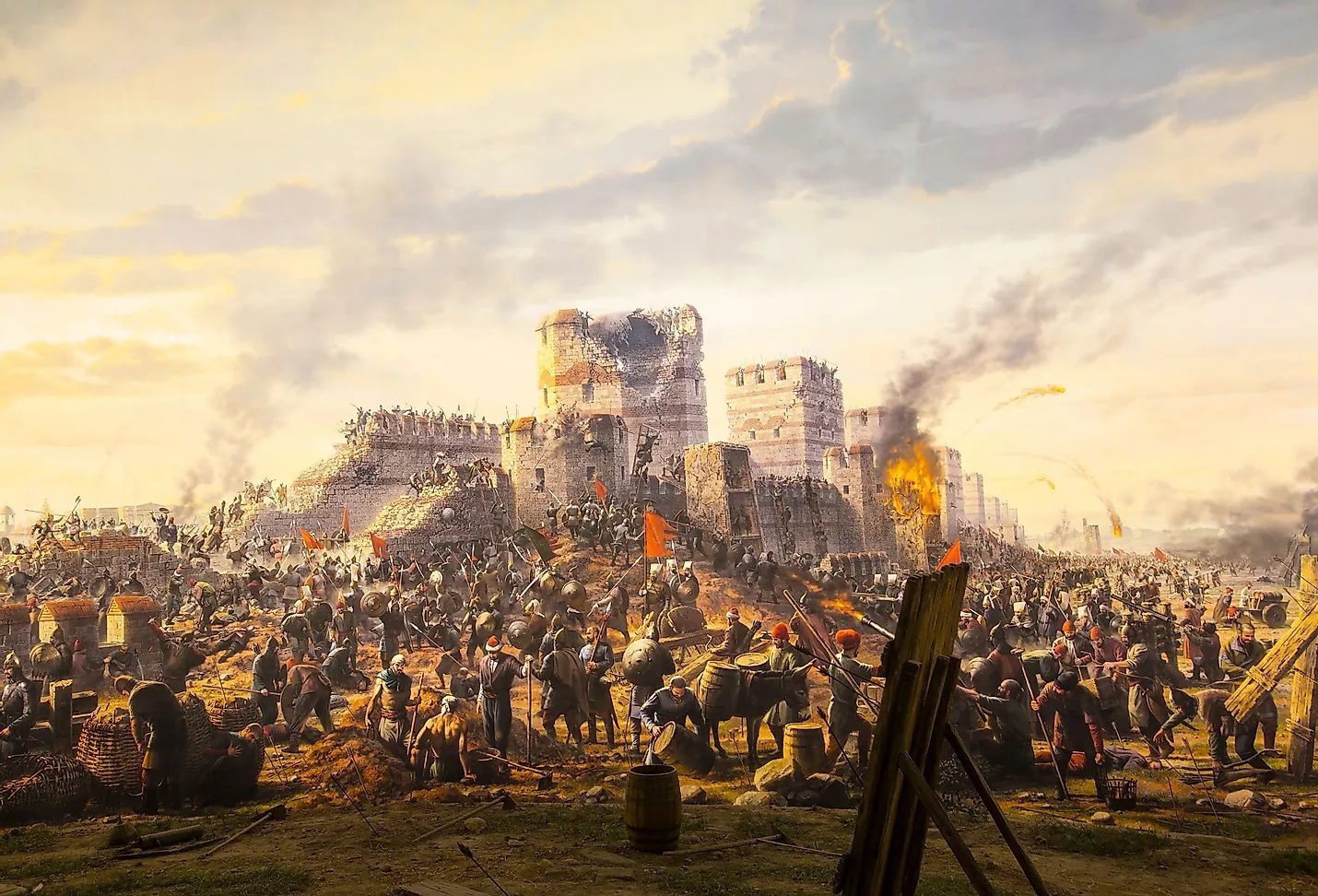
Painting of the Siege of Constantinople by Ioanna Zikakou (1453)
Western European kingdoms like Portugal, Britain, Spain, France and Holland had had enough. The Arabs charged a high tax on spices, and then the Italian states further hiked up the prices. Spending so much money on middlemen sounded a little unnecessary. What if there was a way they could reach the East on their own? What if there was another Route to the Riches?
The Age of Exploration
Portugal begins its Westward journey to reach the East (1453 CE)
Portugal started sailing towards the west and the south to find an alternate way to Asia. The idea was to try to circumvent the continent of Africa.
Vasco da Gama reaches India successfully (1497 CE)
The first voyage to India and back was achieved by Vasco da Gama under the patronage of the Portuguese royal court.
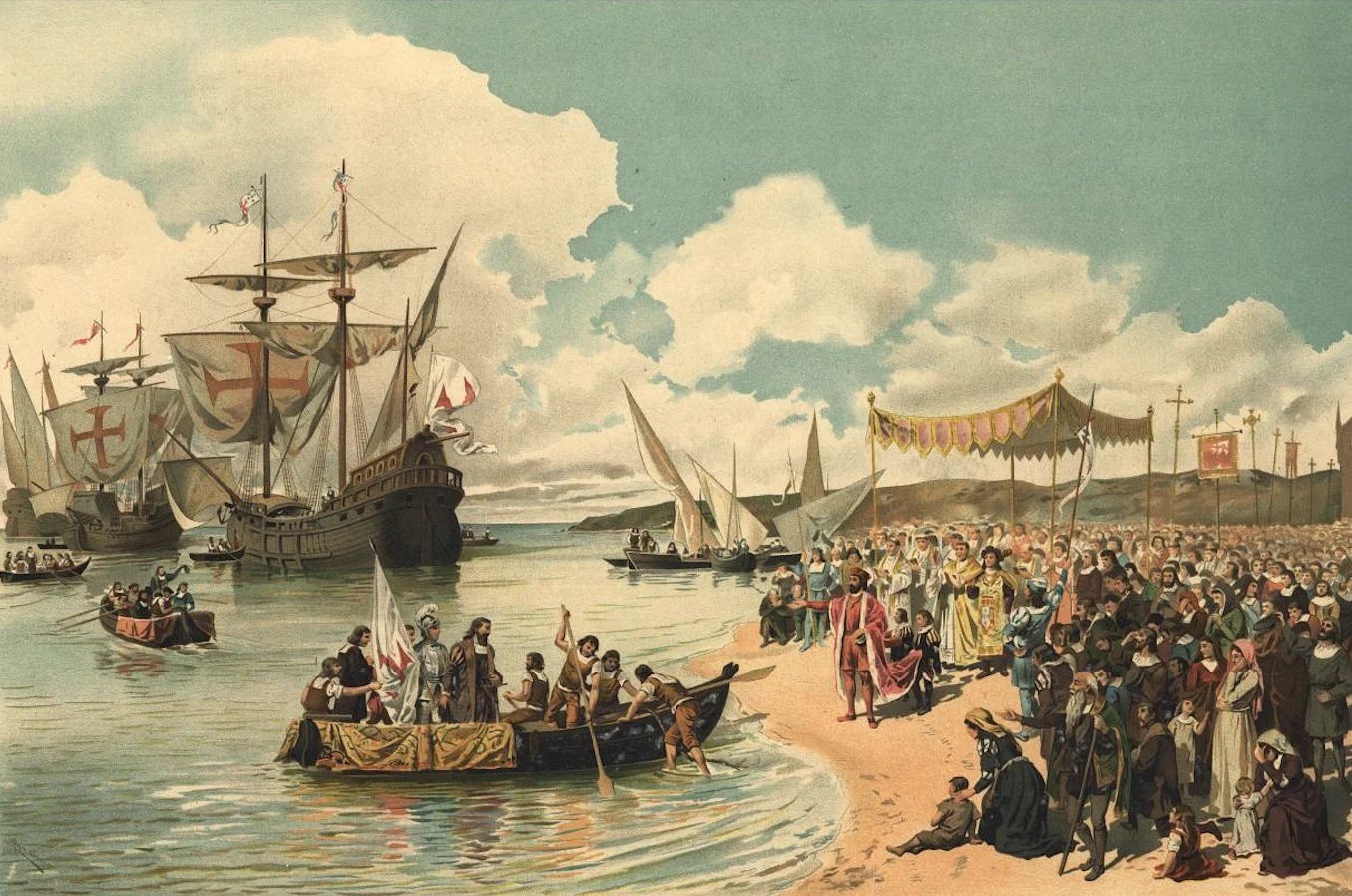
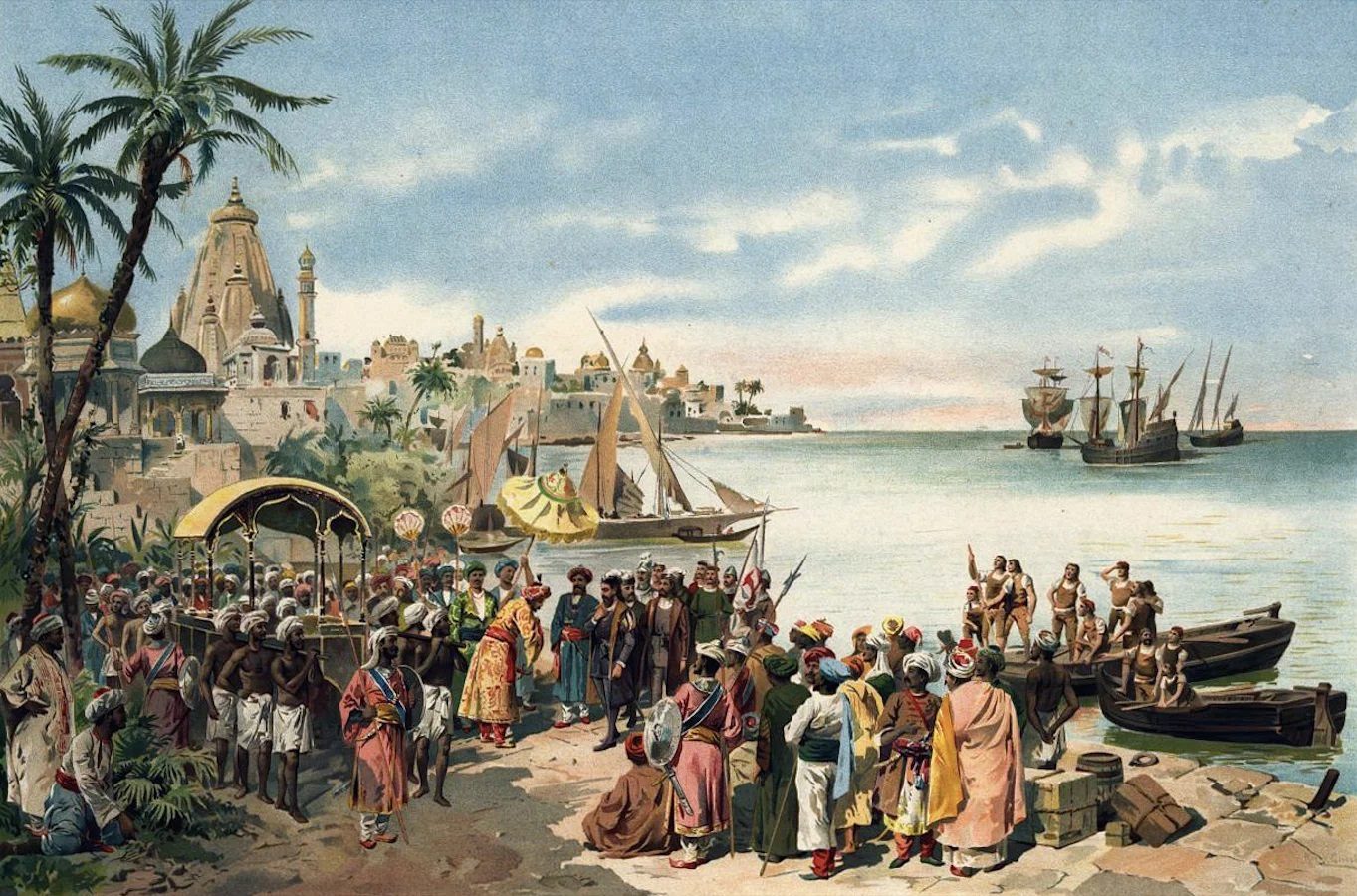
Vasco da Gama arriving at Calicut by Alfredo Roque Gameiro (1900)
Departure of Vasco de gamma to India by Alfredo Roque Gameiro (1900)
Portuguese Domination on the Indian Ocean (1500-1600 CE)
The journey to India, called the Cape Journey, was a trade secret that the Portuguese held for around 100 years, giving them full domination over the Indian Ocean and the spice trade.
The Portuguese took over several ports and islands to establish a stronghold on the entire maritime trade. They also reached to Malacca in the search of its rich spice treasures.
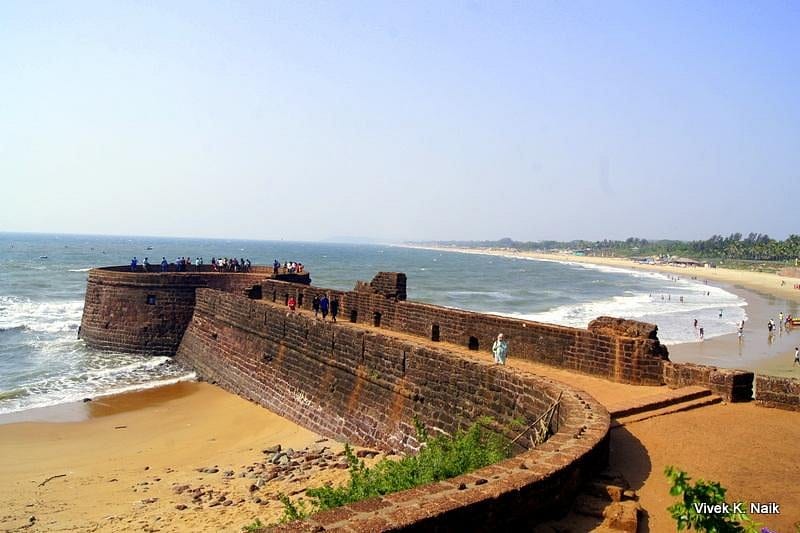
Portuguese Fort Aguada (Goa), built in 1612
This route, taken by Vasco da Gama and subsequently perfected by other Portuguese sailors was a difficult journey to make. Navigating through the peculiar Atlantic Ocean currents, staying safe from pirates, and knowing the right directions for the Cape Route to Asia gave Portugal an edge that no one had at that time. The Portuguese guarded these secrets well, to prevent any other players from entering the lucrative Spice Trade.
Jan Huyghen van Linschoten was a secretary to the Archbishop of Goa, a Portuguese colony in India. During his time in Goa, he gathered information about navigation routes and trade in the Indian Ocean, including the Cape Route.
Jan Huygen van Linschoten, from the princeps edition of Itinerario
Itinerario by Jan Huyghen van Linschoten
Van Linschoten published Itinerario in 1596, providing detailed information about the geography, navigation, and trade routes in the Indian Ocean, including the routes to and from the East Indies. Van Linschoten's book became a valuable resource for European sailors and merchants, leading to other countries set out on the seas to get their share of the Spice Trade.
Leaking the Secrets of the Cape Route
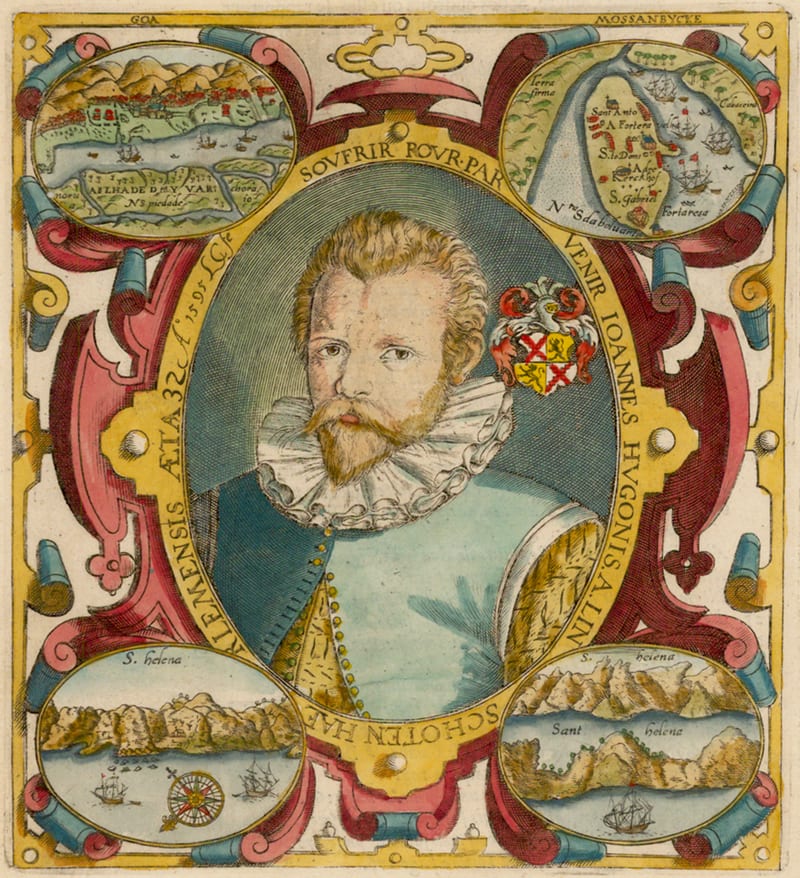
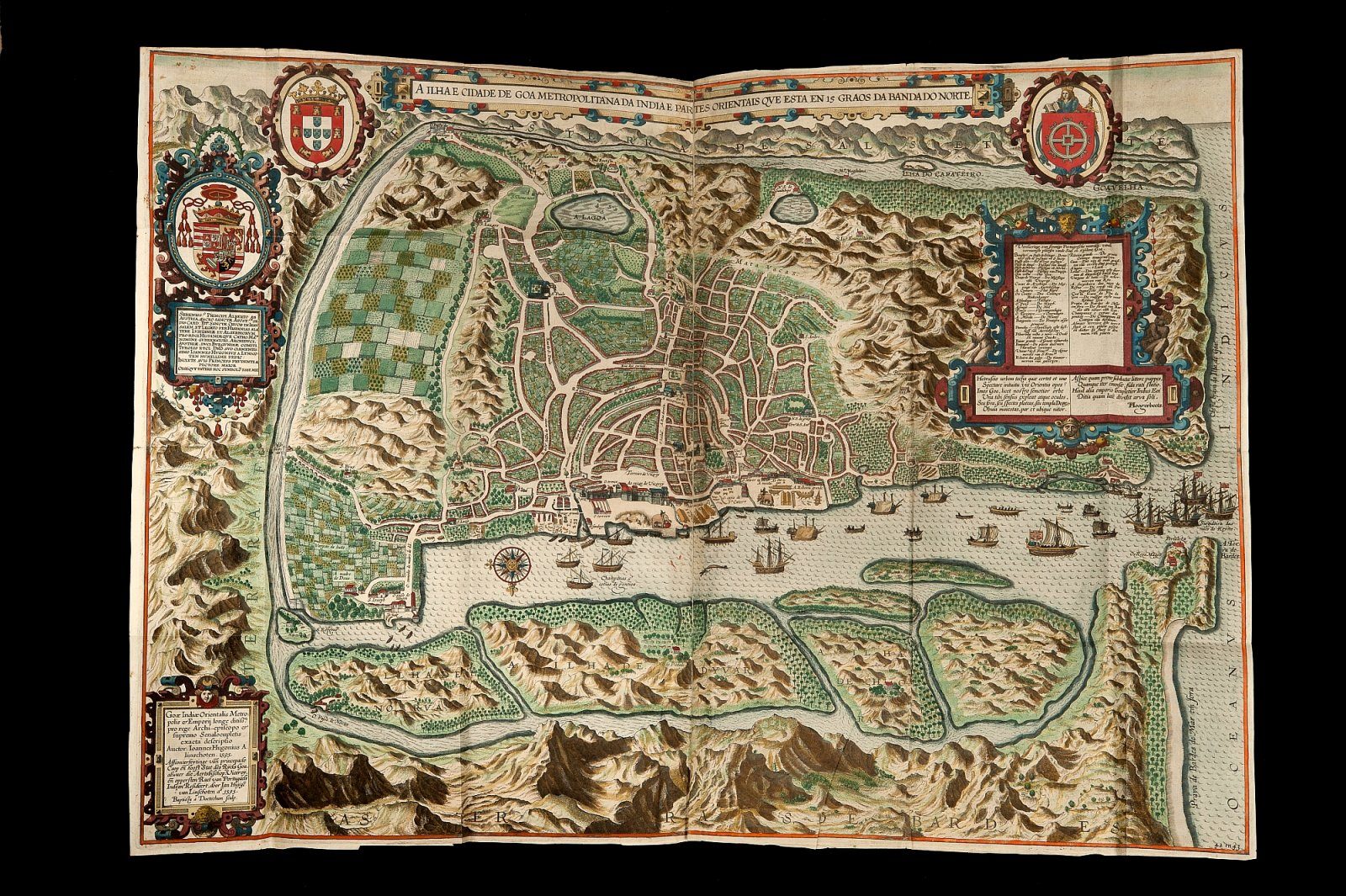
The Spice Race (1600-1800 CE)
After Portugal's success, other European countries like Britain, Spain, France Netherlands were eyeing on the Silk Trade. After Itinerario was published, more ships started voyaging out to Asia. This started a Spice Race where all these countries were fighting for a bigger share by capturing various places in Asia, in order to establish their stronghold on the trade.
Colonial Occupation (till mid-19th c.)
The race to have a monopoly over the trade of valuables like spices led to many European kingdoms capturing places in the Indian and South East Asian regions. Eventually over the 18th century, their trade interests started changing to administrative interests. And soon came a time of exploitation and occupation, changing the world forever. The colonial mindset of taking as much wealth and resources as possible from these areas led to far larger repercussions for these areas.
Note: This map only shows British and Portuguese occupation as a broad idea. It is important to keep in mind that other European countries like France, Netherlands, Spain etc also had areas in these regions. This map only accounts for the regions of India and SE Asia. SE Asia was also later colonised by the Dutch.
The history of the spice trade, from its ancient roots to the era of colonialism, reveals a complex tapestry of commerce, exploration, and imperialistic ambitions. The fascination with exotic spices inspired civilizations to embark on perilous journeys, establishing vast trade networks that connected distant lands and cultures. As the spice trade evolved, the colonial mindset driven by economic interests reshaped the course of history. European powers, driven by the profitability of spice commerce, sought not only access to coveted goods but also dominion over the regions producing them.
A Lesson in History
The pursuit of profit gradually transformed into a broader imperialistic agenda, marking the onset of colonization in places like India and Southeast Asia. The establishment of trading posts and colonies was accompanied by a legacy of exploitation, where indigenous populations faced the brunt of economic and cultural suppression, and forced labour. The colonial era left a deep mark on the socio-political landscapes of these regions, influencing their fate for centuries to come.
In understanding the history of the spice trade, we see not only the fascinating stories of ancient voyages and the exchange of cultures but also the darker chapters of colonization and exploitation. The spice trade's journey from the aromatic bazaars of the ancient world to the colonial power struggles serves as a strong reminder of how economic pursuits, when coupled with a colonial mindset, can reshape the destinies of nations and change the course of history.




